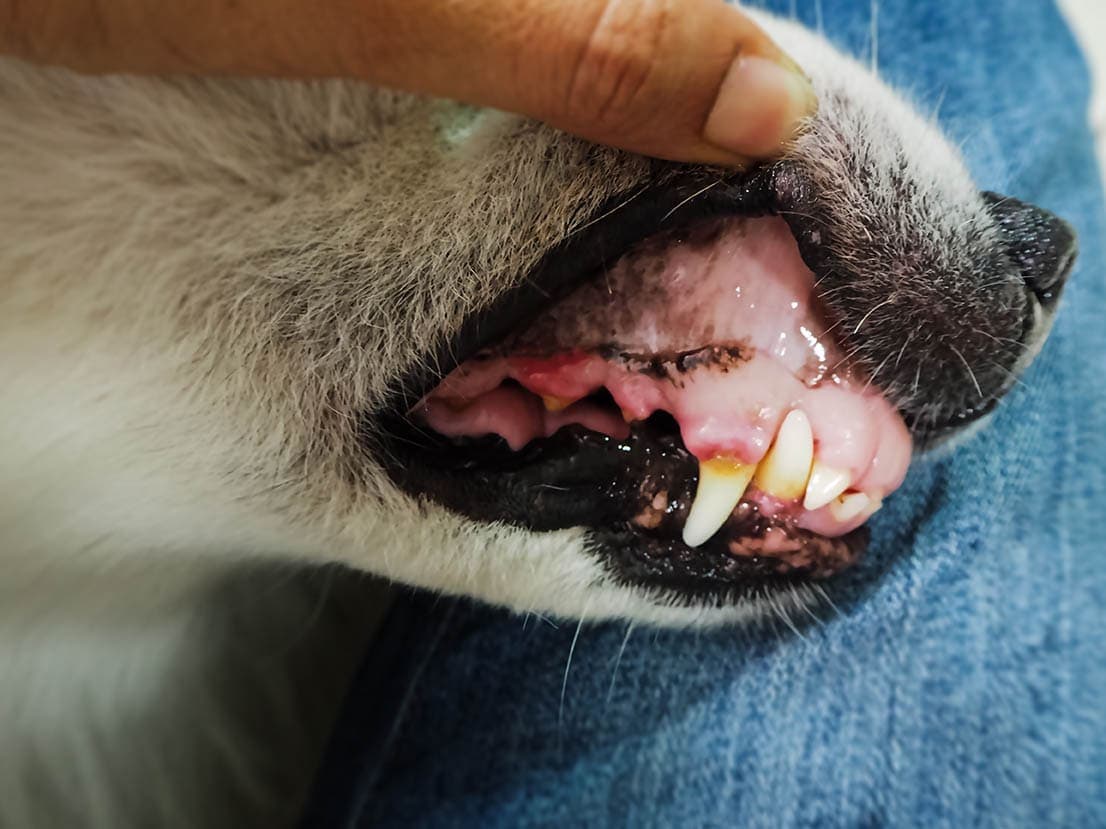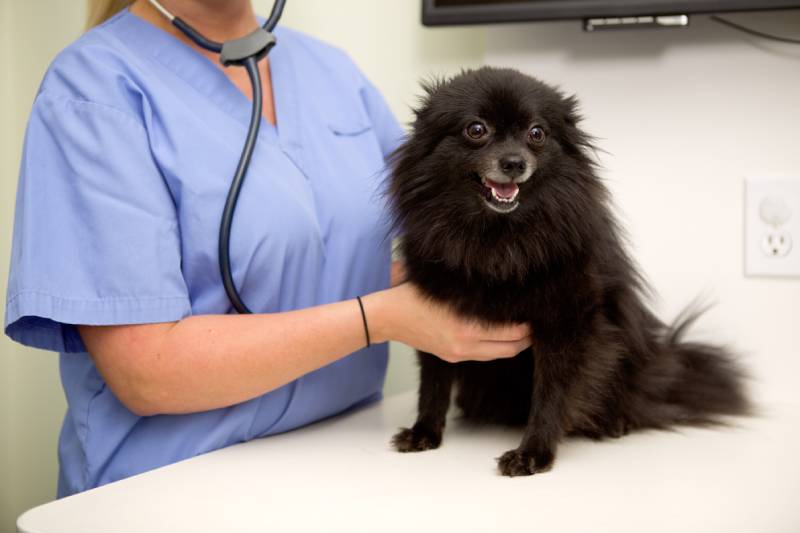What Are Normal Dog Vital Signs & How to Measure Them

Updated on

Our pets can tell us a lot when we take the time to listen. While they can’t easily articulate when they’re sick, assessing your dog’s vital signs can immediately tell you if they are silently suffering and need medical attention. When we know how to monitor indicators like heartbeat and temperature, we can ensure our pets avoid worsening health threats and overcome any emergency.
As you can imagine, monitoring a dog’s vitals isn’t as straightforward as checking a human’s. Their anatomy is much different from ours, as are the standards for respiratory rate, heart rate, and other health markers. If you’re concerned about your pet’s health, here’s everything you need to know about checking your dog’s vital signs.
How to Check Dog’s Vital Signs
1. Check the Gums – Capillary Refill Time
Capillary refill time (CRT) is the best way to check if your dog’s circulation is adequate throughout the tissues. As one of the few areas that let you easily view your dog’s blood flow, the gums are the primary place to check the CRT.
How to Check Your Dog’s Capillary Refill Time in The Gums
Lift your dog’s upper lip to expose the gums. They should be bright pink, indicating adequate blood flow, good oxygen levels, and healthy teeth. It isn’t uncommon for some breeds to have dark spotting on their gums, but there should be at least some underlying pink coloration to assess.
To check your dog’s CRT, press down on the pink gums with the pad of your finger for a few seconds. The gum will whiten when you do this. When you release, the gums should return to pink in under two seconds. If the gums take longer to regain color, your dog could be dealing with a significant health issue, such as shock or heart failure, needing immediate attention.
An abnormal gum color can be a sign of an underlying health issue. Pale or white gums could be a sign of several severe issues, including:
- Anemia
- Shock
- Kidney disease
- Internal bleeding
- Heart disease
- Metal poisoning
Off colors like blue or gray could indicate poor oxygenation due to an illness like pneumonia or heart failure, while a yellow color is a typical sign of jaundice. As with a low CRT, coloration like this requires immediate veterinary attention.

2. Check Respiration – Breathing Rate
Your dog’s breathing rate can clue you into their heart health and let you know when it’s time to see your vet. Respiration rates will shift with more physical activity, temporary stress, or temperature changes, but it usually stays between 15–30 breaths per minute while the dog is at rest.
Breathing rates below that range are typically not an issue in an otherwise healthy dog. Abnormally high rates, on the other hand, may indicate heart or respiratory disorders. Other signs of health issues that typically accompany a rapid breathing rate include:
- Difficulty breathing
- Raspy or noisy breathing
- Coughing and gagging
- Loss of appetite
- Depression, withdrawal, restlessness, and agitation
- Weakness and fainting
How to Check Your Dog’s Breathing Rate
Let your dog relax before measuring their breathing rate. Count each inhale and exhale as one breath. Set a timer for 30 seconds, and count how many breaths your dog takes. Multiply that by two to get their breaths per minute. For most healthy dogs, the resting respiratory rate is 15–30 breaths per minute.
If your dog’s breathing rate seems unusually high, check it several times over the next half an hour to see if it remains consistent. Your vet may need to adjust medications if your dog already has heart health problems. Sudden and extreme changes in your dog’s breathing and the appearance of other signs require an emergency visit to a veterinary hospital.
Checking your dog’s breathing rate is essential in helping your vet manage your dog’s heart health. Practicing at home and getting a feel for your dog’s typical heart rate will make it easier to identify when something is wrong. During the learning phase, your vet will usually instruct you to check the respiratory rate once daily for at least seven days or until you become comfortable with the process and your dog’s normal breathing.

3. Check the Pulse – Heart Rate
A dog’s heart rate can change considerably over its lifetime. Puppy heart rates will be around 160–200 bpm at birth before ramping up to roughly 220 bpm by 2 weeks. As an adult, the rate will slow to 60–160 bpm. Toy dogs generally have faster heart rates of 120–160 bpm, while large dogs over 30 pounds have lower rates hovering around 60–120 bpm.
How to Get a Dog’s Pulse
With your dog standing or lying still, place the pads of your pointer and middle fingers against the inside of your dog’s upper thigh. Press gently, feeling for the pulsing femoral artery. Time the number of beats for 15 seconds and multiply by four to find the beats per minute.
You can also try placing your hand over your dog’s chest to take the pulse from the heart. Taking your dog’s vitals this way is sometimes easier on smaller dogs. Talk to your vet for help checking your pet’s heart rate if you have difficulty.
An elevated heart rate can stem from something as simple as temporary anxiety or physical activity. It could also indicate heart disease, lung disease, heat stroke, anemia, and several other potential pathological causes. Check your dog’s heart rate and follow up with your vet when you notice other signs of distress, such as lethargy, collapse, unusual eating habits, or vomiting.

4. Check the Temperature
When your dog seems lethargic, disinterested in food, or otherwise out of sorts, you may want to check if they have a fever. Oral and non-contact thermometers don’t work on dogs. As with cats, taking your dog’s temperature at the ear may be a viable option, but the most accurate reading will come from a digital rectal thermometer.
How to Check Your Dog’s Temperature
Wipe down the thermometer with alcohol before use. Apply a small amount of a water-based lubricant, such as KY Jelly, to the thermometer to ease insertion. Lift your dog’s tail and gently insert the thermometer. Hold it in place until it beeps. Normal body temperature is 99°F–102.5°F (37.5 to 39 °C), with lower or higher temperatures requiring immediate attention.
Young puppies will have a lower temperature at around 95°F–99°F (35° to 37.2°C). They should reach the normal adult temperature range within a month after birth. Remember that puppies are very delicate, so please avoid taking the puppy’s body temperature unless your veterinarian specifically instructs you to.
Tools to Read Your Dog’s Vitals
As your dog ages and checking vital signs becomes an everyday ritual, consider a smart dog collar to help you keep tabs on changes. These devices can send updates on your dog’s health to your smartphone and provide other benefits, including activity tracking or GPS.
Being discerning of the differences between products is crucial. Many products on the market act as fitness trackers, giving insights into sleep patterns, calories burned, and overall activity. Although they can clue you into underlying health problems affecting your dog’s behavior, they don’t read vital signs.
Newer devices use ultra-wideband radar and AI in non-invasive methods to check your dog’s temperature, heart rate, and respiration. The Invoxia Smart Dog Collar and PetPace Collar are two innovators in the market, offering ongoing monitoring and instant alerts to keep you aware of changing health conditions. They require monthly subscriptions and won’t replace the need to double-check your dog’s vitals, but constant monitoring can provide peace of mind for owners.
Final Thoughts
Dogs reliably stay in tune with their owners’ feelings, so it’s only fair to be conscious of changes in our pets, even when they can’t tell us if something is wrong. Now is the perfect time to start monitoring your dog’s well-being. When you become more in touch with their vital signs and comfortable checking them, you’ll minimize vet visits and bills while maximizing your dog’s quality of life.
Featured Image: O_Lypa, Shutterstock













